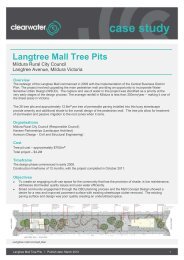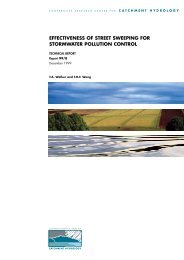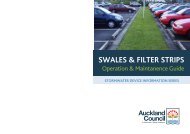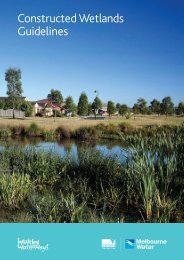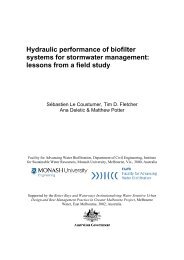INFILTRATION DEVICES - HCCREMS
INFILTRATION DEVICES - HCCREMS
INFILTRATION DEVICES - HCCREMS
You also want an ePaper? Increase the reach of your titles
YUMPU automatically turns print PDFs into web optimized ePapers that Google loves.
WATER SMART Practice Note 5<br />
<strong>INFILTRATION</strong> <strong>DEVICES</strong><br />
S Y S T E M O V E R V I E W<br />
Infiltration devices can be used as a sole<br />
approach or in unison with rainwater<br />
tanks, porous paving and landscape<br />
measures (see Practice Notes 4, 6 and 7<br />
respectively) to manage stormwater. An<br />
infiltration device collects the rain that<br />
falls on site, stores it temporarily and<br />
then releases it slowly into the ground.<br />
There are three parts of an infiltration<br />
device:<br />
1. Site drainage system<br />
The site drainage system e.g. roof gutters,<br />
downpipes, paths and driveways<br />
which collect and deliver stormwater to<br />
the infiltration device.<br />
Table 1: Types of pollutants and mechanisms to protect infiltration devices<br />
Type of<br />
pollutants<br />
System<br />
Protection<br />
Roof water<br />
Environment<br />
Protection<br />
System<br />
Protection<br />
Stormwater<br />
Environment<br />
Protection<br />
Gross <br />
Particulate<br />
matter <br />
Soluble<br />
As required<br />
Protection<br />
mechanisms<br />
- Leaf guards<br />
- First flush device<br />
- Leaf screen<br />
- Sediment trap<br />
- Contour banks<br />
- Vegetation<br />
- Grass swales<br />
- Biofiltration<br />
strips<br />
- Wetlands<br />
2. Pre-treatment system<br />
The pre-treatment system receives water<br />
runoff prior to entering an infiltration device<br />
to remove gross pollutants, particular<br />
matter and soluble pollutants. Pretreatment<br />
protects and maximises the life<br />
of the infiltration device and improves the<br />
quality of water entering the environment.<br />
Table 1, outlines the types of pollutants<br />
found in different water sources<br />
and mechanisms used to protect the<br />
infiltration device and/or improve water<br />
quality.<br />
3. Infiltration retention<br />
system<br />
The retention system stores roof water and<br />
stormwater until it can percolate into the<br />
surrounding soil (Fig 1). There are a number<br />
of options for using stormwater infiltration<br />
on residential properties. The most<br />
commonly used systems are:<br />
• leaky wells<br />
• retention trenches<br />
• infiltration basins.<br />
Fig 1: A typical infiltration strategy<br />
T Y P E S O F S Y S T E M S<br />
1. Leaky wells<br />
A leaky well consists of a vertical perforated<br />
pipe with a lid at the ground surface<br />
and an open bottom. Stormwater enters<br />
via an inlet pipe at the top and an overflow<br />
pipe caters for excess stormwater.<br />
The holes in the walls and the open bottom<br />
are covered with geotextile fabric to<br />
cleanse stormwater as it percolates into<br />
the surrounding soil (see Figure 2).<br />
Leaky wells store stormwater until it can<br />
percolate to the surrounding soil. Before<br />
entering the device, all stormwater should<br />
be filtered by a sediment trap to remove<br />
sediment, leaves and debris. An advantage<br />
of the leaky well is that the accessible<br />
chamber allows sediment to be readily removed.<br />
Consequently it is more resistant to<br />
failure due to clogging. Note that the dimensions<br />
shown in Figure 2 are nominal.<br />
© <strong>HCCREMS</strong> 2007 WaterSmart Practice Note No 5 2







